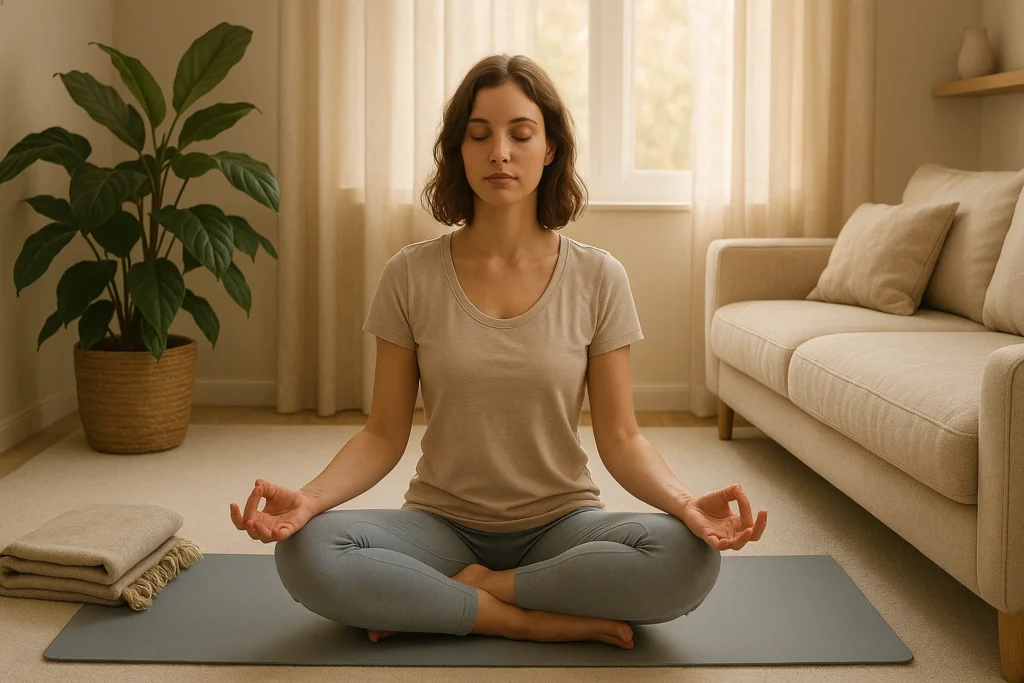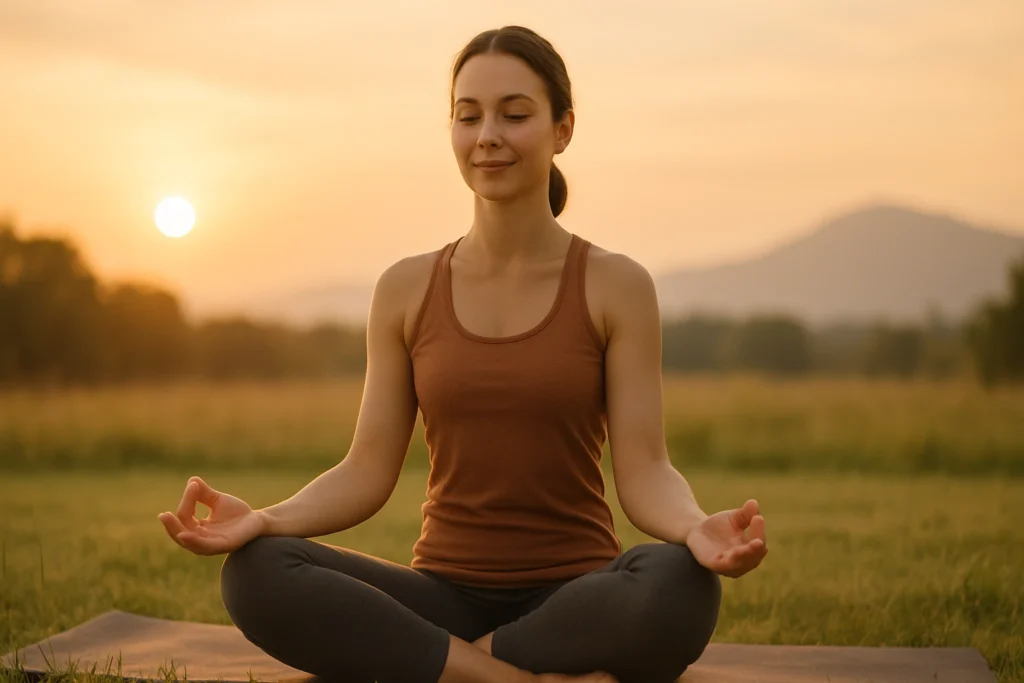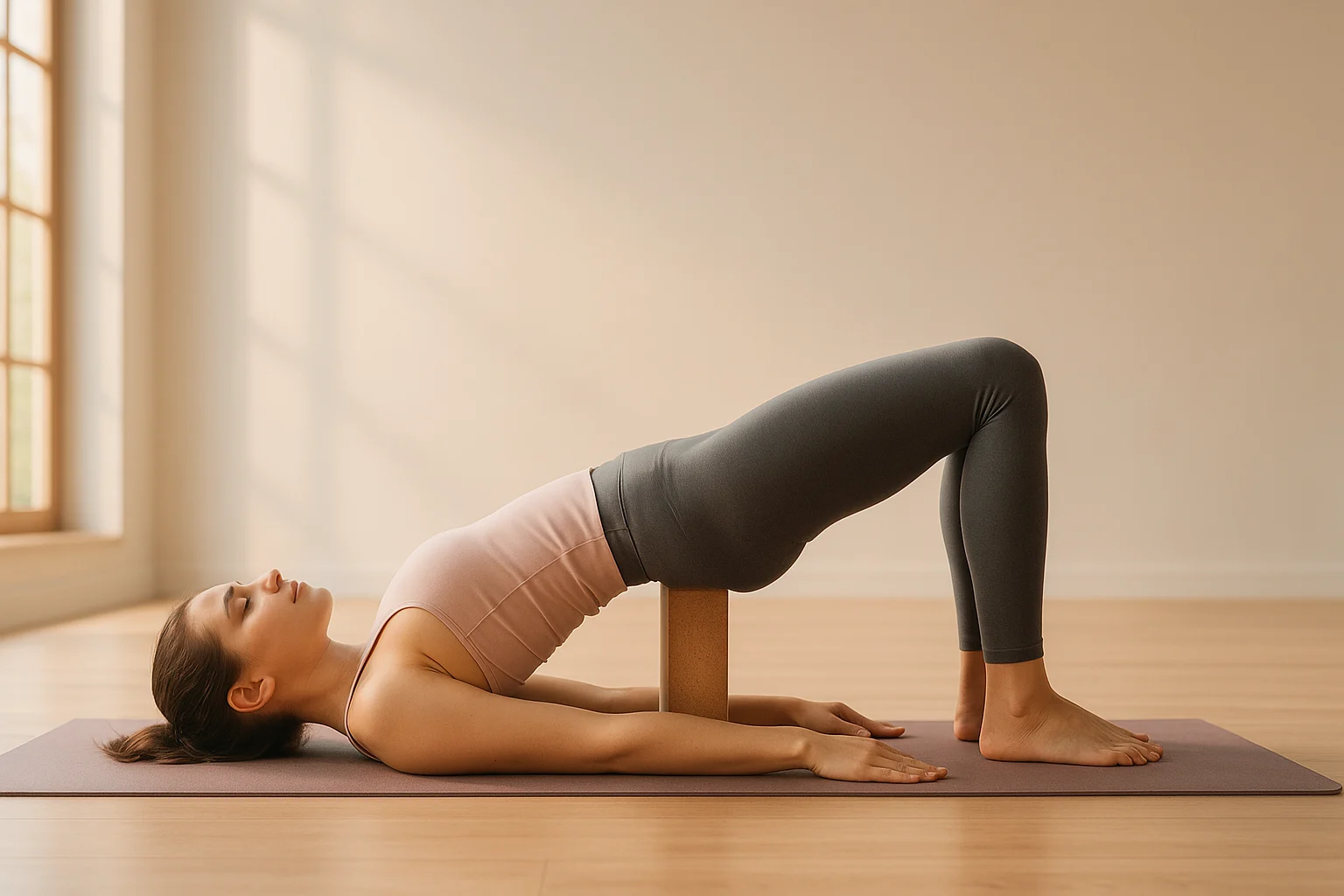
Struggling to hold a pose or reach your toes in class? Yoga blocks can quietly change the whole feel of a pose. Plenty of yogis lean on them to grow their practice. Used in yoga prop exercises, they make shapes more reachable, help you deepen stretches with care, and even support strength work. Whether you’ve just rolled out your first mat or you’ve been practicing for years, a simple yoga blocks exercise can change the way you move—helping you bring the floor closer, improve alignment, or add an extra challenge. Ready to see how these small props can make a big impact? For a complete look at mats, straps, and other essentials too, check out our full yoga gear guide.
Find Your Perfect Pose!This page contains paid/affiliate links. As an Amazon Associate we earn from qualifying purchases, and we may earn commissions from other partners—at no extra cost to you. Links marked with ‘#ad’ are affiliate links, meaning we may earn a commission at no extra cost to you. Learn more.
Table of Contents
Key Takeaways
- Versatile Tools: Yoga blocks work for everyone, making poses easier or tougher depending on your needs.
- Balance + Strength Boost: Using blocks adds stability and activates muscles in ways you might not expect.
- Better Alignment: They help you stay in comfortable positions, reducing the risk of strain.
- Foam vs. Cork: Foam blocks are soft and easy to carry; cork blocks provide sturdy support.
- Modify Poses: Blocks let you tweak popular poses to fit your body.
Why a Yoga Blocks Exercise Helps Your Practice
Adding yoga prop exercises to your routine can refresh your yoga flow. Think yoga blocks are just for beginners? Nope, they’re for everyone! These clever props open up poses, let you stretch deeper without overdoing it, and even push seasoned yogis to new heights. For those looking to enhance their practice further, exploring yoga straps for flexibility can complement blocks beautifully.
How Do Yoga Blocks Improve Balance and Stability?
Standing on one leg can feel like you’re trying out for a tightrope act. I’ve been there—teetering in Half Moon until a block saved the day. Slide a block under your hand in Half Moon or Triangle and the floor simply meets you, which steadies the pose. Then your attention can stay with your breath, not the wobble. That firm support also builds confidence for those trickier standing shapes.
Safe Stretching with Yoga Blocks
Can’t quite reach your toes in a forward fold? No sweat! Blocks under your hands keep your spine long and happy, avoiding strain. Take Seated Forward Fold, for example—using blocks lets you ease into a deeper hamstring stretch without rounding your back. This approach builds flexibility in a supportive way, making a yoga blocks exercise your secret weapon for progress. For targeted stretches, check out our guide on yoga hamstring stretches to deepen your flexibility practice.
“Yoga blocks aren’t a crutch; they’re a bridge to deeper understanding and more comfortable practice.”
Enhancing Alignment and Posture
Good alignment is everything for staying comfortable and getting the most out of your practice. In Triangle Pose, a block under your hand helps keep your spine long. Many instructors note that blocks can reduce perceived strain in alignment-focused poses. Over time, this can build muscle memory for better posture, whether you’re on the mat or just walking around.
Building Strength with Yoga Blocks
Blocks can effectively add challenge to your workout. Try squeezing one between your thighs in Bridge Pose or Plank—it fires up your inner thighs and core. A yoga blocks exercise like this turns every pose into a strength-building opportunity, making support feel like a challenge. For more ways to boost strength, explore our yoga sequence for core strength.
Comfort and Relaxation in Restorative Poses
Not every session needs to be sweaty. In restorative work, blocks add a small, kind lift that helps you settle. Rest your head on a block in Savasana or prop your knees in Supported Bridge. That little bit of height invites your body—and your mind—to exhale. To enhance relaxation, consider pairing blocks with mindfulness techniques for stress for a holistic approach.
Yoga Block Pose Finder
Tap your goal to get a pose idea and a gear tip.
Choosing Your Perfect Yoga Block: Foam vs. Cork 🧱
Ready to grab some blocks? You’ve got foam or cork to choose from, each with its own vibe. Curious about other ways to use them? Take a peek at Yoga Journal’s guide on leveling up with blocks.
Foam vs. Cork Yoga Blocks
VSQuick pick: Choose cork for standing balance and stability; choose foam for restorative comfort and easy travel.
| Format | Gaiam Foam Yoga Blocks (2-Pack) |
Trideer Cork Yoga Blocks (2-Pack) |
|---|---|---|
|
Great for restorative, meditation, and taking to class. |
Confidence for Triangle, Half Moon, and other standing poses. |
|
| Form |
|
|
| Pack size |
|
|
| Why choose this |
|
|
| Pros |
|
|
| Consider |
|
|
| Shop |
Basic Principles for a Yoga Blocks Exercise
Got your blocks ready? Here’s how to use them so your practice feels safer and more rewarding.
Embrace Blocks Without Hesitation
Forget the myth that props are only for beginners. Blocks let you tailor a pose to your body, keeping alignment honest and easing strain. Using them isn’t a crutch—it’s simply smart yoga.
Understand the Three Heights
- Flat (Lowest): A steady base for gentle support, like under your head.
- Side (Medium): Offers a moderate lift for standing poses or hip support.
- End (Tallest): Gives maximum height for deep stretches or tight hamstrings.
Mess around with the heights to find what clicks best with your body.
Place Blocks Strategically
- Under Hands: Great for standing poses or forward folds to keep your spine long.
- Under Hips/Sacrum: Perfect for supported backbends or seated comfort.
- Between Thighs/Knees: Engages your core and inner thighs for extra strength.
- Under Head/Neck: Ideal for sinking into restorative relaxation.
Listen to Your Body 👂
Treat blocks like allies, not referees. If something feels off, move the block or change the height. Let your body call the shots—go for sensation, not pain.
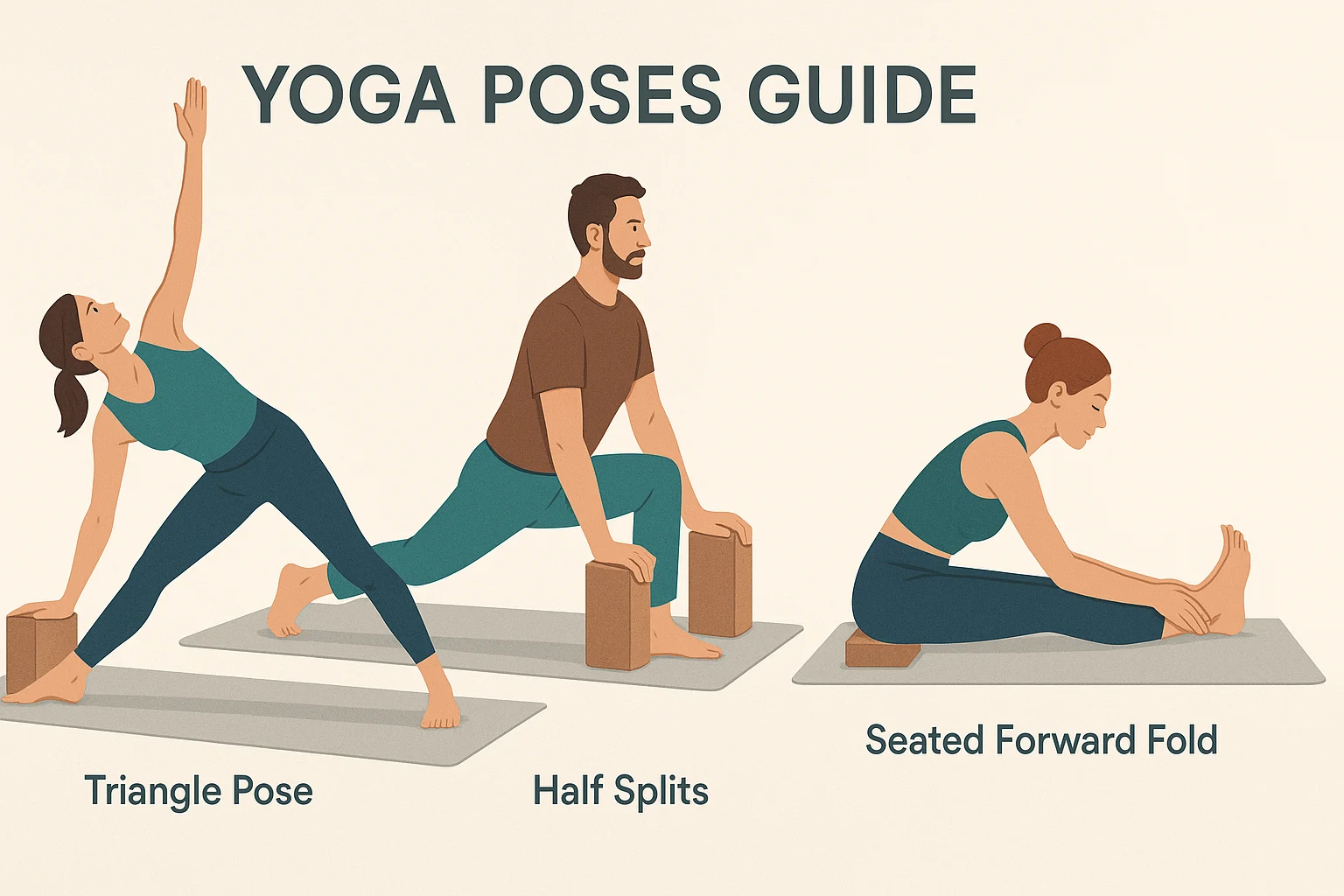
Easy Yoga Blocks Exercise Poses for Every Yogi
These block yoga poses work for everyone—whether you’re new to yoga or a pro looking to polish your practice. Ready to see how blocks can steal the show? Let’s check out some beginner-friendly moves.
Block Yoga Poses: Triangle (Trikonasana)
This standing pose stretches your sides and strengthens your legs, with blocks making it more accessible.
- Stand with feet 3–4 feet apart, right foot out 90 degrees, left foot slightly turned in.
- Extend your arms, shift hips left, reach your right hand forward, then down to a block outside your right foot.
- Raise your left arm up, stacking hips. Look at your thumb or down, whatever feels good.
- Hold for 30 seconds, then switch sides.
Benefits: Stretches hips and hamstrings while boosting balance.
Prefer extra stability? Try a cork block (our pick) #ad.
Supported Bridge Pose (Setu Bandhasana)
This gentle backbend opens your chest and soothes your mind—ideal for chilling out.
- Settle in on your back, bend your knees, keep feet hip-width apart, and bring your heels close to your fingertips.
- Lift your hips and slide a block under your sacrum (pick flat, medium, or tall height).
- Let your weight rest on the block, relaxing your glutes. Arms can rest by your sides.
- Breathe deeply for 1–5 minutes, noticing the stretch.
- Lift hips slightly, remove the block, and lower your spine slowly.
Benefits: Opens your chest and promotes deep relaxation.
Half Splits (Ardha Hanumanasana)
Got tight hamstrings? This pose with blocks makes stretching feel easier and more supported.
- From a Low Lunge (right foot forward), place blocks on either side of your foot.
- Shift hips back, straighten your right leg, and flex your foot.
- Place hands on blocks, keeping your spine long. Hinge forward for a deeper stretch.
- Hold for 30 seconds, then switch sides.
Benefits: Stretches hamstrings and prepares you for splits.
Seated Forward Fold (Paschimottanasana)
This pose stretches your entire back body, and blocks make it more doable.
- Sit with legs extended, maybe on a block to tilt your pelvis forward.
- Place blocks in front of your feet (flat, medium, or tall).
- Inhale to lengthen your spine; exhale and hinge forward, hands on blocks or feet.
- Hold for 1–3 minutes, keeping your spine long.
Benefits: Stretches hamstrings and spine and can help you relax.
Want a gentler feel on wrists? A foam block (our pick) is kinder on contact points #ad.
Low Lunge (Anjaneyasana)
Open up tight hip flexors with this supported lunge that feels amazing.
- From tabletop, step your right foot forward, knee over ankle.
- Place blocks under your hands on either side of the mat.
- Slide your left knee back, feeling a stretch in your hip flexors. Keep your chest lifted.
- Hold for 30 seconds, then switch sides.
Benefits: Stretches hip flexors and strengthens glutes.
If kneeling makes you hesitate in Low Lunge or Half Splits, a slim knee pad can change that fast—no wobble, no bulk. This compact pad is a studio-friendly favorite for steady grip and easy cleanup.
Pick: Heathyoga Yoga Knee Pad Cushion — compact, grippy support that takes the sting out of kneeling so you can focus on form.
Slip it under the back knee in Low Lunge or under both knees for Half Splits; it rolls up with your mat for class or travel.
Plank with Block Squeeze
This dynamic yoga blocks exercise is an effective way to build core strength.
- In Plank, place a block between your inner thighs or ankles.
- Squeeze the block to engage your core and thighs.
- Hold for 30 seconds, keeping a straight line from head to heels.
Benefits: Engages your core and inner thighs.
No blocks yet? A starter set with strap covers basics for strength and flexibility #ad.
Child’s Pose (Balasana)
A restful pose that’s even cozier with blocks for support.
- Kneel with big toes touching and knees wide.
- Place a block under your forehead or chest for extra support.
- Rest your arms forward or by your sides, breathing deeply for 1–3 minutes.
Benefits: Relaxes your spine, hips, and shoulders.
How Many Blocks Do You Need?
For most yoga block workouts, two blocks are usually enough. Symmetrical shapes like Supported Bridge—or balance work like Half Moon—often feel better with support on both sides. Having a pair gives you room to experiment. For eco-conscious choices, explore our guide to hypoallergenic yoga mats to complement your sustainable practice.
Want one grab-and-go kit that covers 90% of block work? A 2-block + 8′ strap bundle is the easy win—balanced support plus length for safer folds. This straightforward set is a reader favorite for dependable basics.
Pick: Syntus Yoga Blocks + 8′ Strap Set — a simple two-block kit with a D-ring strap so folds feel safer and symmetry comes naturally.
Use the strap to keep your spine long in forward folds; the matching 9×6×4 blocks give steady, even support on both sides.
Beyond the Basics: Advanced Yoga Block Workouts
- Elevated Hands: Place hands on blocks in Plank or Downward Dog to increase upper-body and core work.
- Instability for Core: Try Boat Pose with your feet on a block to intensify your core challenge.
- Deeper Backbends: In Wheel Pose, place blocks under your hands for more lift. Start in Bridge, set blocks under hands (flat), push up into Wheel, and hold for 10–20 seconds.
- Handstand Prep: Place hands on blocks against a wall, squeeze a block between thighs, and practice kicking up for better stability.
- Child’s Pose Variation: Place a block under your chest with arms extended for a deeper shoulder stretch. Hold for 1–2 minutes.
Many teachers observe that using blocks can support alignment and make advanced work feel more accessible. Sprinkling these block-based workouts into your flow may help you build strength gradually and practice with confidence.
Real Stories: Yogis Share Their Block Journeys 🧘♀️
Wondering how this lands for real people? Here’s how a few yogis say blocks shifted their practice:
- Sarah (Beginner): “I couldn’t even get close to my knees in a forward fold. Blocks in Triangle Pose kept my back straight and gave me the confidence to keep going.”
- Mark (Experienced): “Using blocks under my hands in Wheel Pose gave me the lift I needed to deepen my backbend without strain.”
- Emily (Injured): “After a hamstring injury, blocks in Half Splits let me stretch gently, helping me return to practice more comfortably.”
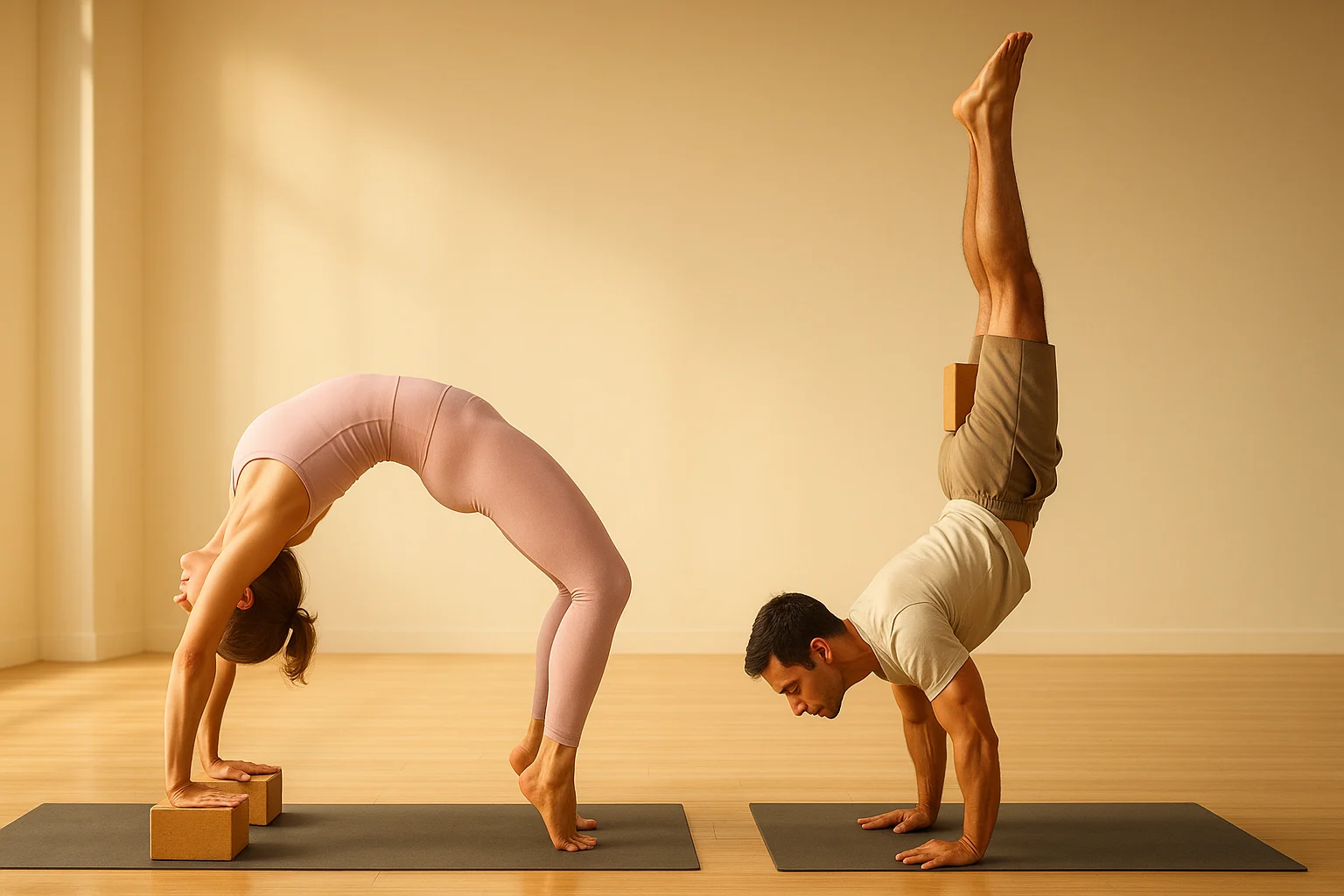
Frequently Asked Questions
The Journey Continues: Embracing Your Yoga Block Practice
Yoga blocks are more than gear; they’re steady companions. They help you explore balance, build strength, and soften into flexibility. Keep experimenting with heights and placement, listen in, and let your practice evolve. Grab your blocks, roll out your mat, and enjoy the support.
Compare foam vs. cork blocks
